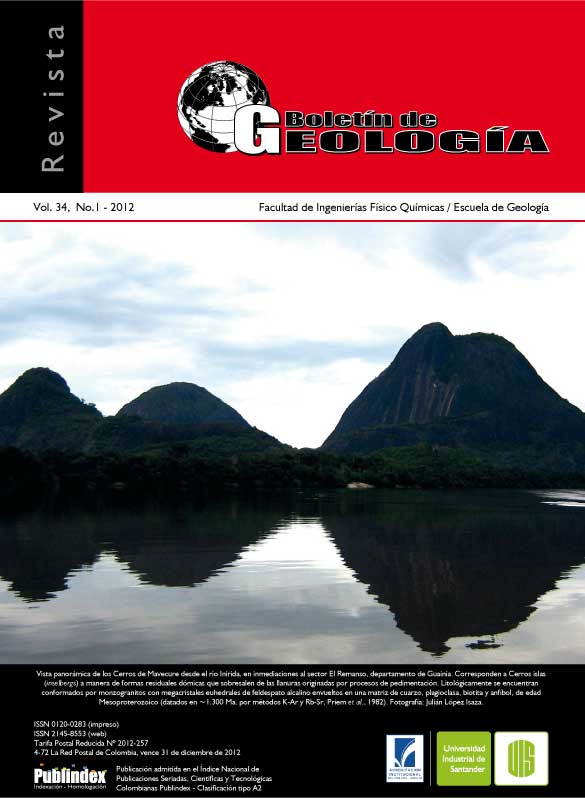¿FOSSIL BONE OR SIMPLE ROCK? SPECTROSCOPY FTIR AND CRITERIATO FOSSILIZED BONE STRUCTURES IDENTIFICATION
Published 2012-08-24
How to Cite
Abstract
Fossil record of marine vertebrates is very important to the reconstruction of systematic phylogenies,evolutionary and ecological studies, for this reason, any taphonomic element must be analyzed with quick and simple technical before it is discarded. In this study, was evaluated the biological origin of a similar structure to the vertebrae with Infrared spectroscopy analysis FTIR. The structure was collected in the Paja Formation(Cretaceous: Aptian) of the municipality of La Mesa de los Santos (Santander, Colombia). Samples of the outerlayer and the filling matrix were extracted using a microdrill. Along cow´s bone (Bos taurus) was used as a control sample to determine the spectrum of calcium phosphate. FTIR spectra allowed identification of differences inthe composition of the outer layer and the internal structure of the specimen. A response was found in the absorption ranges to calcium phosphate in the outer layer. The internal layer showed a greater composition ofcalcium carbonate. The FTIR technique allowed the recognition of calcium phosphate in this taphonomic entity.Current paleontological criteria determine that the morphology and the spectra IR not support the recognition of this element like fossil ossified structure due to the absence of the characteristic microstructure.
Keywords: Aptian, Marine Reptile, Pseudofossil, Paja Formation.
Downloads
References
Bhargava, R.,Wang, S., and Koenig, L. 2003.FTIR Microspectroscopy of Polymeric Systems.Advances in Polymer Science, 163: 93-96
Cadena-Rueda, E.A., and Gaffney, E. S. 2005.Notoemyszapatocaensis, a New Side-Necked Turtle (Pleurodira: Platychelyidae) from the EarlyCretaceous of Colombia. American Museum Novitates.American Museum of Natural History.No. 3470
Chinsamy, A., and Hurum, J.H. 2006. Bone microstructure and growth patterns of early mammals. ActaPalaeontologicaPolonica,51 (2): 325–338
Clarke, J., and Barker, M. 1995. Abnormal histology in an Iguanodon caudal centrum from the lower Cretaceous of the Isle of Wight. Paleontology, 38(4): 905-914
De Figueiredo-Souto, P.R. 2006. Use of Infrared Spectroscopy Analysis to Fossil Structures of Baru Basin, Brazil.Geociencias, 25 (1): 99-104.
Díaz, J. E., Contreras, N. M., Pinto, J. E., Velandia, F., Morales, C. J., e Hincapié, G. 2009. Evaluación Hidrogeológica Preliminar de las Unidades Geológicas de La Mesa de los Santos, Santander. Boletín de Geología, UIS, 31(1): 61-70
Edwards, N.P., Barden H.E., van Dongen, B.E., Manning, P.L., Larson P.L., Bergmann, U., Sellers, W.I., and Wogelius, R.A. 2011. Infrared mapping resolves soft tissue preservation in 50 million year-old reptile skin. Proceedings of the Royal Society B.Manuscrito en imprenta.doi:10.1098/rspb.2011.0135.
Fernández López, S.R. 2000. Temas de Tafonomía.Departamento de Paleontología. Facultad de CienciasGeológicas. Universidad Complutense de Madrid, 167p
García, R.C.A., y Campos, A.N.O. 2000. Composición Química y Mineralógica de las Biotitas Metamórficas del Sector Central del Macizo de Santander, Colombia. Boletín de Geología, UIS, 22(37): 18-27
Hallgren, L. 1987. Infrared spectroscopy analysis of fossil coprolites. Scientific Publications of the Science Museum of Minnesota, 6(2): 1-31.
Hill, R.R., and Rendel, D.A. E. 1975.The Interpretation of Infrared Spectra.London: Heyden, 375 pp.
Holtz, M., and Schultz, C.L. 1998.Taphonomy of the South Brazilian Triassic Herpetofauna: fossilization mode and implications for morphological studies. Lethaia, 31: 335-345.
